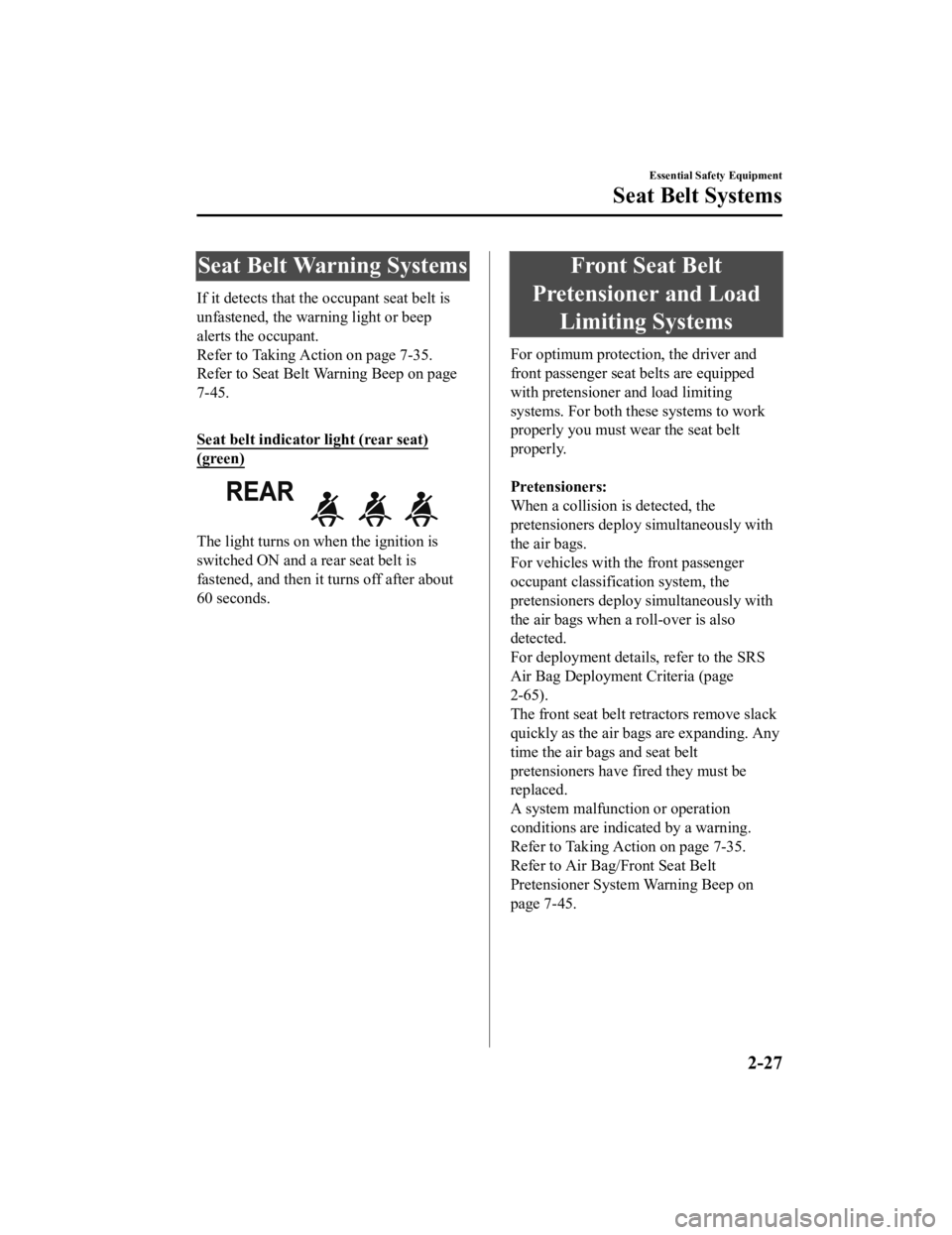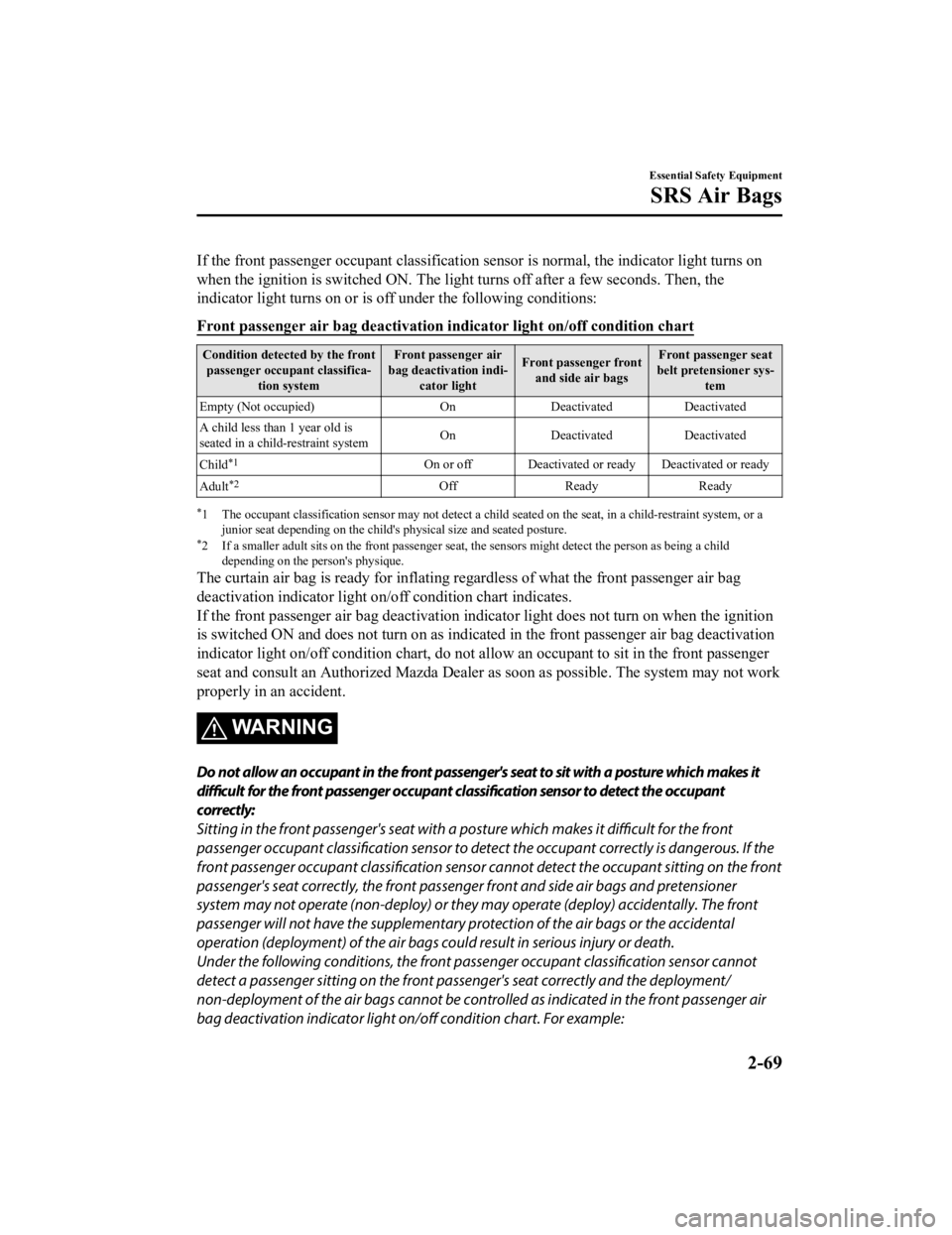air condition MAZDA MODEL 6 2021 Owners Manual
[x] Cancel search | Manufacturer: MAZDA, Model Year: 2021, Model line: MODEL 6, Model: MAZDA MODEL 6 2021Pages: 634, PDF Size: 71.37 MB
Page 3 of 634

Thank you for choosing a Mazda. We at Mazda design and build vehicles with complete
customer satisfaction in mind.
To help ensure enjoyable and trouble-free operation of your Mazda, read this manual
carefully and follow its recommendations.
An Authorized Mazda Dealer knows your vehicle best. So when mai ntenance or service is
necessary, that's the place to go.
Our nationwide network of Mazda professionals is dedicated to p roviding you with the best
possible service.
We assure you that all of us at Mazda have an ongoing interest in your motoring pleasure
and in your full satisfaction with your Mazda product.
Mazda Motor Corporation
HIROSHIMA, JAPAN
Important Notes About This Manual
Keep this manual in the glove com partment as a handy reference for the safe and enjoyable use of your Mazda.
Should you resell the vehicle, leave this manual with it for th e next owner.
All specifications and descriptio ns are accurate at the time of printing. Because improvement is a constant goal
at Mazda, we reserve the right to make changes in specifications at any time without notice and without obliga‐
tion.
Air Conditioner and the Environment
Your Mazda's genuine air condit ioner is filled with a refrigerant that has been found not to damage the earth's
ozone layer. If the air conditione r does not operate properly, consult an Authorized Mazda Dealer.
Perchlorate
Certain components of this vehicle such as [air bag modules, se at belt pretensioners, lithium batteries,…] may
contain Perchlorate Material-- Special handling may apply for s ervice or vehicle end of life disposal. See
www.dtsc.ca.gov/hazardouswaste/perchlorate.
Please be aware that this manual applies to all models, equipme nt and options. As a result, you may find
some explanations for equipment not installed on your vehicle.
©2020 Mazda Motor CorporationAugust 2020 (Print1)
A Word to Mazda Owners
Mazda6_8JN3-EA-20H_Edition1_old 2020-6-18 17:31:27
Page 5 of 634

Table of Contents
Pictorial Index
Interior, exterior views and part identification of your Mazda.1
Essential Safety Equipment
Important information about safet y equipment, including seats, seat belt
system, child-restraint systems and SRS air bags.2
Before Driving
Use of various featur es, including keys, doors, mirrors and windows.3
When Driving
Information concerning s afe driving and stopping.4
Interior Features
Use of various features for ride comfort, including air-conditi oning and
audio system.5
Maintenance and Care
How to keep your Maz da in top condition.6
If Trouble Arises
Helpful information on what to do if a problem arises with the vehicle.7
Customer Information and Reporting Safety Defects
Important consumer information including warranties and add-on
equipment.8
Specifications
Technical informati on about your Mazda.9
Index10
Mazda6_8JN3-EA-20H_Edition1_old 2020-6-18 17:31:27
Page 41 of 634

Seat Belt Warning Systems
If it detects that the occupant seat belt is
unfastened, the warning light or beep
alerts the occupant.
Refer to Taking Action on page 7-35.
Refer to Seat Belt Warning Beep on page
7-45.
Seat belt indicator light (rear seat)
(green)
The light turns on when the ignition is
switched ON and a rear seat belt is
fastened, and then it turns off after about
60 seconds.
Front Seat Belt
Pretensioner and Load Limiting Systems
For optimum protectio n, the driver and
front passenger seat belts are equipped
with pretensioner and load limiting
systems. For both these systems to work
properly you must wear the seat belt
properly.
Pretensioners:
When a collision is detected, the
pretensioners deploy simultaneously with
the air bags.
For vehicles with the front passenger
occupant classification system, the
pretensioners deploy simultaneously with
the air bags when a roll-over is also
detected.
For deployment details, refer to the SRS
Air Bag Deployment Criteria (page
2-65).
The front seat belt retractors remove slack
quickly as the air bags are expanding. Any
time the air bags and seat belt
pretensioners have fired they must be
replaced.
A system malfunction or operation
conditions are indicated by a warning.
Refer to Taking Action on page 7-35.
Refer to Air Bag/Front Seat Belt
Pretensioner System Warning Beep on
page 7-45.
Essential Safety Equipment
Seat Belt Systems
2-27
Mazda6_8JN3-EA-20H_Edition1_old 2020-6-18 17:31:27
Page 44 of 634

Do not use an improper extender:
Using a seat belt extender that is for
another person or a different vehicle or seat
is dangerous. The seat belt will not provide
adequate protection and the user could be
seriously injured in an accident. Only use
the extender provided for you and for the
particular vehicle and seat. NEVER use the
extender in a different vehicle or seat. If you
sell your Mazda, do not leave your seat belt
extender in the vehicle. It could be used
accidentally by the new owner of the
vehicle. After removing the seat belt
extender, discard it. Never use the seat belt
extender in any other vehicle you may own
in the future.
Do not use an extender that is too long:
Using an extender that is too long is
dangerous. The seat belt will not fit
properly. In an accide nt, the seat belt will
not provide adequate protection and you
could be seriously injured. Do not use the
extender or choose one shorter in length if
the distance between the extender's buckle
and the center of the user's body is less
than 15 cm (6 in).Do not leave a seat belt extender
connected to the buckle:
Leaving a seat belt extender connected to
the buckle without using the seat belt is
dangerous. When the seat belt extender is
connected to the driver's seat belt buckle
(or front passenger's seat belt buckle), the
SRS driver's (or front passenger's) air bag
system will determine that the driver (or
front passenger) is wearing the seat belt
even if the driver (or front passenger) is not
wearing it. This condition could cause the
driver's (or front passenger's) air bag to not
activate correctly and result in death or
serious injury in the event of collision.
Always wear the seat belt with the seat belt
extender.
Do not use the seat belt extender when
installing a child-restraint system on the
front or rear passenger seat:
Using a seat belt extender to fasten a
child-restraint system on any seat is
dangerous. Always follow the
child-restraint system manufacturer's
installation instructions and never use a
seat belt extender.
NOTE
When not in use, remove the seat belt
extender and store it in the vehicle. If the
seat belt extender is left connected, the
seat belt extender might get damaged as it
will not retract with the rest of the seat belt
and can easily fall out of the door when
not in use and be damaged. In addition,
the seat belt warning light will not
illuminate and function properly.
Essential Safety Equipment
Seat Belt Systems
2-30
Mazda6_8JN3-EA-20H_Edition1_old 2020-6-18 17:31:27
Page 48 of 634

Seating a child in a child-restraint system on the front passenger seat is dangerous under
certain conditions (With Front Passenger Occupant Classification System):
Your vehicle is equipped with front passenger occupant classification sensor. Even with the
front passenger occupant classification sensor, if you must use the front passenger seat to
seat a child, using a child-restraint system on the front passenger seat under the following
conditions increases the danger of the front passenger air bag deploying and could result in
serious injury or death to the child.
The front passenger air bag deactivation indica tor light does not illuminate when seating a
child in the child-restraint system.
Luggage or other items are placed on the seat with the child in the child-restraint system.
A rear passenger or luggage pushing or pulling down on the front passenger seatback.
Luggage or other items are placed on the seatback or hung on the head restraint.
The seat is washed.
Liquids are spilled on the seat.
The front passenger seat is moved backward, pushing into luggage or other items placed
behind it.
The front passenger seatback contacts the rear seat.
Luggage or other items are placed between the front passenger seat and driver seat.
An electric device is put on the front passenger's seat.
An additional electrical device, such as a seat warmer is installed to the surface of the front
passenger seat.
The designated positions with seat belts on the rear seats are the safest places for children.
Always use seat belts and child restraints.
Do not allow a child or anyone to lean over or against the side window of a vehicle with side
and curtain air bags:
It is dangerous to allow anyone to lean over or against the side window, the area of the front
passenger seat, the front and rear window pilla rs and the roof edge along both sides from
which the side and curtain air bags deploy, even if a child-restraint system is used. The impact
of inflation from a side or curtain air bag could ca
use serious injury or death to an out of
position child. Furthermore, leaning over or against the front door could block the side and
curtain air bags and eliminate the advantages of supplemental protecti on. With the front air
bag and the additional side air bag that comes out of the front seat, the rear seat is always a
better location for children. Take special care no t to allow a child to lean over or against the
side window, even if the child is seated in a child-restraint system.
Essential Safety Equipment
Child Restraint
2-34
Mazda6_8JN3-EA-20H_Edition1_old 2020-6-18 17:31:27
Page 72 of 634

Do not operate a vehicle with damaged air bag/seat belt pretensioner system components:
Expended or damaged air bag/seat belt pretensioner system components must be replaced
after any collision which caused them to depl oy or damage them. Only a trained Authorized
Mazda Dealer can fully evaluate these systems to see that they will work in any subsequent
accident. Driving with an expended or damage d air bag or pretensioner unit will not afford
you the necessary protection in the event of any subsequent accident which could result in
serious injury or death.
Do not remove interior air bag parts:
Removing any components such as the front se ats, front dashboard, the steering wheel or
parts on the front and rear window pillars and along the roof edge, containing air bag parts
or sensors is dangerous. These parts contain essential air bag components. The air bag could
accidentally activate and cause serious injuri es. Always have an Authorized Mazda Dealer
remove these parts.
Properly dispose of the air bag system:
Improper disposal of an air bag or a vehicle with live air bags in it can be extremely
dangerous. Unless all safety procedures are foll owed, injury could result. Have an Authorized
Mazda Dealer safely dispose of the air bag sy stem or scrap an air bag equipped vehicle.
NOTE
If it becomes necessary to have the components or wiring system for the supplementary
restraint system modified to accommodate a person with certain medical conditions in
accordance with a certified physician, contact an Authorized Mazda Dealer, refer to
“Customer Assistance (U.S.A.)” (page 8-2).
When an air bag deploys, a loud inflation noise can be heard and some smoke will be
released. Neither is likely to cause injury, however, the text ure of the air bags may cause
light skin injuries on body parts not covered with clothing through friction.
Should you sell your Mazda, we urge you to tell the new owner of its air bag systems and
that familiarization with all instructions about them, from the Owner's Manual, is
important.
This highly-visible label is displayed wh ich warns against the use of a rear-facing
child-restraint system on the front passenger seat.
(Except Mexico) (Mexico)
Essential Safety Equipment
SRS Air Bags
2-58
Mazda6_8JN3-EA-20H_Edition1_old 2020-6-18 17:31:27
Page 78 of 634

▼Warning Light/Beep
A system malfunction or operation conditions are indicated by a
warning.
Refer to Contact Authorized Mazda Dealer and Have Vehicle Inspected on page 7-28.
Refer to Warning Sound is Activated on page 7-45.
Essential Safety Equipment
SRS Air Bags
2-64
Mazda6_8JN3-EA-20H_Edition1_old 2020-6-18 17:31:27
Page 82 of 634

Front Passenger Occupant Classification System*
First, please read "Supplemental Restraint System (SRS) Precaut ions" (page 2-53) carefully.
▼Front Passenger Occupant Classification Sensor
Your vehicle is equipped with a front passenger occupant classi
fication sensor as a part of
the supplemental restraint system. This sensor is equipped in the front passenger's seat
cushion. This sensor measures the electrostatic capacity of the front passenger's seat. The
SAS unit is designed to prevent the front passenger front and side air bags and seat belt
pretensioner system from deploying if the front passenger air b ag deactivation indicator
light turns on.
To reduce the chance of injuries caused by deployment of the fr ont passenger air bag, the
system deactivates the front passenger front and side air bags and also the seat belt
pretensioner system when the front passenger air bag deactivati on indicator light turns on.
Refer to the following table fo r the front passenger air bag de activation indicator light
illumination conditions.
This system shuts off the front passenger front and side air bags and seat belt pretensioner
system, so make sure the front passenger air bag deactivation i ndicator light turns on
according to the following table.
The air bag/front seat belt pretensioner system warning light f lashes and the front passenger
air bag deactivation indicator li ght illuminates if the sensors have a possible malfunction. If
this happens, the front passenger front and side air bags and s eat belt pretensioner system
will not deploy.
Front passenger air bag de activation indicator light
This indicator light turns on to remind you that the front pass enger front and side air bags
and seat belt pretensioner wil l not deploy during a collision.
Essential Safety Equipment
SRS Air Bags
2-68*Some models.
Mazda6_8JN3-EA-20H_Edition1_old 2020-6-18 17:31:27
Page 83 of 634

If the front passenger occupant classification sensor is normal, the indicator light turns on
when the ignition is switched ON. The light turns off after a f ew seconds. Then, the
indicator light turns on or is off under the following conditio ns:
Front passenger air bag deactivation indicator light on/off con dition chart
Condition detected by the front
passenger occupant classifica‐ tion system Front passenger air
bag deactivation indi‐ cator light Front passenger front
and side air bags Front passenger seat
belt pretensioner sys‐ tem
Empty (Not occupied) OnDeactivated Deactivated
A child less than 1 year old is
seated in a child-restraint system On
Deactivated Deactivated
Child
*1On or off Deactivated or ready Deactivated or ready
Adult
*2Off Ready Ready
*1 The occupant classification sensor may not detect a child seat ed on the seat, in a child-restraint system, or a
junior seat depending on the ch ild's physical size and seated posture.
*2 If a smaller adult sits on the front passenger seat, the sensors might detect the person as being a child
depending on the person's physique.
The curtain air bag is ready for inflating regardless of what the front passenger air bag
deactivation indicator light on/ off condition chart indicates.
If the front passenger air bag d eactivation indicator light does not turn on when the ignition
is switched ON and does not turn on as indicated in the front p assenger air bag deactivation
indicator light on/off condition chart, do not allow an occupan t to sit in the front passenger
seat and consult an Authorized Mazda Dealer as soon as possible . The system may not work
properly in an accident.
WARNING
Do not allow an occupant in the front passenger's seat to sit with a posture which makes it
difficult for the front passenger occupant
classification sensor to detect the occupant
correctly:
Sitting in the front passenger's seat with a posture which makes it difficult for the front
passenger occupant classification sensor to dete ct the occupant correctly is dangerous. If the
front passenger occupant classification sensor ca nnot detect the occupant sitting on the front
passenger's seat correctly, the front passeng er front and side air bags and pretensioner
system may not operate (non-deploy) or they may operate (deploy) accidentally. The front
passenger will not have the supplementary prot ection of the air bags or the accidental
operation (deployment) of the air bags could result in serious injury or death.
Under the following conditions, the front passenger occupant classification sensor cannot
detect a passenger sitting on the front passenger's seat correctly and the deployment/
non-deployment of the air bags cannot be controlled as indicated in the front passenger air
bag deactivation indicator light on/off condition chart. For example:
Essential Safety Equipment
SRS Air Bags
2-69
Mazda6_8JN3-EA-20H_Edition1_old 2020-6-18 17:31:27
Page 99 of 634

In the storage compartments such as
the glove compartment or the center
console
On the rear parcel shelf
Next to a communication device such
as a mobile phone
When the ignition is switched to ACC or
ON, the vehicle lock-out prevention
feature prevents you from locking
yourself out of the vehicle.
All doors and the trunk lid will
automatically unlock if they are locked
using the power door locks with any
door open.
The vehicle lock-out prevention feature
does not operate while the ignition is
switched off.
When all doors and the trunk lid are
locked using the power door lock with
any door or the trunk lid open, the
closed doors and the trunk lid are
locked. After that, when all doors and
the trunk lid are closed, all doors and
the trunk lid are locked. However, if the
key is inside the vehicle, all doors and
the trunk lid are auto matically unlocked.
(With the advanced keyless function)
The beep sound is heard for about 10
seconds to notify the driver that the key
has been left in the vehicle.
(Without the advanced keyless
function)
The horn sound is heard twice to notify
the driver that the key has been left in
the vehicle.
(Door unlock (control) system with
collision detection)
This system automatically unlocks the
doors and the trunk lid in the event the
vehicle is involved in an accident to
allow passengers to get out of the
vehicle immediatel y and prevent being
trapped inside. While the ignition is
switched ON and in the event the vehicle
receives an impact strong enough to
inflate the air bags, all the doors and the
trunk lid are automatically unlocked
after about 6 seconds have elapsed from
the time of the accident.
The doors and the trunk lid may not
unlock depending on how an impact is
applied, the force of the impact, and
other conditions of the accident.
If door-related systems or the battery is
malfunctioning, the doors and the trunk
lid may not unlock depending on your
vehicle type.
Before Driving
Doors and Locks
3-13
Mazda6_8JN3-EA-20H_Edition1_old 2020-6-18 17:31:27